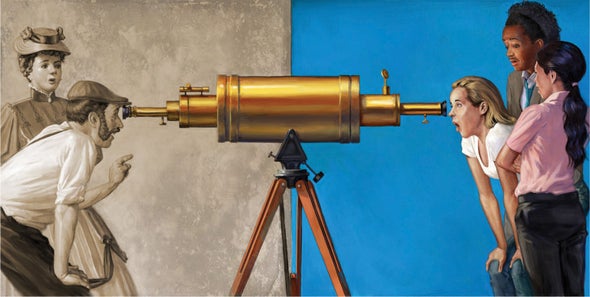A friend had a grandfather named August, who passed away on a September 1st. His widow would later say, “The beginning of September was the end of August.”
Moving on, as perspicacious readers may have noticed, the end of August 2020 was the 175th anniversary of the first issue of Scientific American. In 1921 we published an interview with Marie Curie. In 1950 we ran an article on relativity by Albert Einstein. But even institutions with a long and successful track record are bound to sometimes run off the track. So it comes as no surprise that we've made the occasional boo-boo. Here are some of our best, which in this case means our worst.
Way back in 1846, we shared a terrible notion about boat propellers. “It is truly astonishing,” we wrote, “that men of capital in England ... suppose that a propeller of any form on the screw principle, can compete with the simple Fultonian paddle-wheel.” We missed the fact that as a ship rolls, more of one side of the paddle is submerged, which causes an unbalanced power output. The resulting steering problem is just one reason for the lack today of paddle-wheel aircraft carriers.
In 1869 we floated an idea about how to cross the East River between Manhattan and Brooklyn without a boat or a suspension bridge with big abutments. The proposal involved a large double-decker platform a few feet above the water hanging from a piloted trolley. The trolley would sit on a lightweight, skeletal bridge about 140 feet up and tow the platform back and forth. Transport time from one bank to the other could take as little as one minute. In the end, we decided that a conventional bridge or ferries made more sense than this dangling port of peril. And as a lifelong New Yorker, I feel qualified to note that if there's anything worse than being 140 feet above the East River, it's being just a few feet above it.
We still don't have flying cars. And if humans’ driving ability on the ground is any indication, thank goodness. But back in 1915, we were looking forward to transparent planes: “Military authorities await the development of the new French invisible aeroplane.... Over the [aluminum] framework, instead of canvas, is stretched a transparent material ... called ‘cellon’ ... a chemical combination of cellulose and acetic acid. Of almost the same transparency as glass, it does not crack or splinter and has the toughness and pliability of rubber.” Which is why cellulose acetate is used today for eyeglass frames. Through which you wouldn't see a French invisible plane even if it was a fait accompli.
In 1883 we thought nobody would want telephones: “Despite the fact that recent experiments have demonstrated the possibility of telephoning over long circuits, it is to be doubted if the instrument will be used otherwise than locally.... By telephone it is the sound of a word, and not its vowel and consonants, which the operator receives, and a mistake can easily happen.” Yes, that's why the game is called telephone. Actually we might ultimately have been right—with the advent of texting, many of us apparently prefer those mini telegrams to talking. As comedian Gary Gulman said of the modern phone call, “To me the phone is just this seldom-used app on my phone. And if you use it on me, I am furious.”
Finally, Scientific American in the 1920s was enthusiastic about debunking séance holders who claimed to communicate with the dead. We even offered prizes to any mediums who could withstand the scrutiny of our judges, including Harry Houdini. (We never had to pay.) But in 1923 we advocated that some mediums should be compensated for their efforts. “After all, even a medium must live. Nobody has ever suggested the doctor ought to have a job, on the side, as carpenter or hack driver, earning his living from this and giving such time as he can spare from it to the gratuitous healing of disease.... The medium, to the people he serves, gives just as real a service as does the doctor.... Why ask him to give it for nothing?” Years later we think differently about that service. And we no longer have even any small medium largesse.


